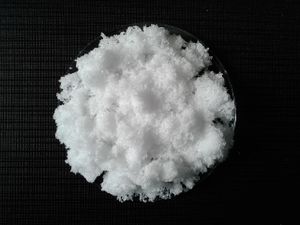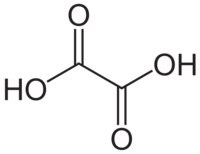Oxalic acid
 Oxalic acid dihydrate sample
| |
 Structure of oxalic acid
| |
| Names | |
|---|---|
| IUPAC name
Oxalic acid
| |
| Systematic IUPAC name
Ethanedioic acid | |
| Other names
1,2-Ethanedioic acid
Aktisal Aquisal Wood bleach | |
| Identifiers | |
| Jmol-3D images | Image |
| |
| Properties | |
| H2C2O4 | |
| Molar mass | 90.035 (anhydrous) 126.066 (dihydrate) |
| Appearance | White hygroscopic crystals |
| Odor | Odorless |
| Density | 1.90 g/cm3 (anhydrous) 1.653 g/cm3 (dihydrate) |
| Melting point | 189.5 °C (373.1 °F; 462.6 K) (sublimes) |
| Boiling point | Sublimes |
| 14.3 g/100 ml | |
| Solubility | Poorly soluble in acetone, POCl3 Insoluble in benzene, chloroform, petroleum ether, toluene, xylene |
| Solubility in diethyl ether | 1.4 g/100 ml (15 °C) |
| Solubility in ethanol | 23.7 g/100 ml (15 °C) |
| Solubility in formic acid | 9.74 g/100 ml (16.8 °C)[1] |
| Solubility in methanol | 27.01 g/100 ml (25 °C)[2] |
| Vapor pressure | 0.001 mmHg (20 °C) |
| Acidity (pKa) | 1.25 4.14 |
| Thermochemistry | |
| Std enthalpy of
formation (ΔfH |
-827.5 kJ/mol |
| Hazards | |
| Safety data sheet | Sigma-Aldrich (anhydrous) Sigma-Aldrich (dihydrate) |
| Flash point | 166 °C |
| Related compounds | |
| Related compounds
|
Oxalates Malonic acid |
| Except where otherwise noted, data are given for materials in their standard state (at 25 °C [77 °F], 100 kPa). | |
| Infobox references | |
Oxalic acid is an organic compound with the chemical formula H2C2O4 or (COOH)2. Along with formic acid, it is one of the most reactive organic acids, but unlike formic acid, pure oxalic acid is solid, non-volatile and can be handled much safer.
Contents
Properties
Chemical
Oxalic acid is very strong for an organic acid (pHa1 = 4.14; pHa2 = 1.25). It will react with manganese dioxide to form manganese oxalate and carbon dioxide.
- MnO2 + 2 H2C2O4 → MnC2O4 + 2 CO2 + 2H2O
Oxalic acid is particularly notable for a number of insoluble salts it forms with common metals, such as magnesium and calcium. Thus, it can be used to displace other acids from these metals' salts, which allows for synthesis of several rare acids.
Heating oxalic acid in conc. sulfuric acid will yield carbon dioxide and carbon monoxide.
- H2C2O4 → CO2 + CO + H2O
Physical
Oxalic acid is a colorless hygroscopic crystalline solid, with a snow-like aspect. It is soluble in water (143 g/L at 25˚C), more soluble in ethanol (240 g/L) but poorly soluble in ether (18 g/L). It has a weak smell and is irritating to skin. It has a melting point of 102 °C and sublimes between 149 - 160 °C.
Availability
Oxalic acid is sometimes available as wood bleach or as beehive disinfecting powder, from beekeeping suppliers. It can also be bought online, such as from Amazon. "Bar Keepers Friend" is a very cheap multi-surface cleaner containing oxalic acid dihydrate, available at hardware stores.
Its name comes from the fact that early investigators isolated oxalic acid from flowering plants of the genus Oxalis, commonly known as wood-sorrels. Oxalic acid can also be found in other plants, such as chives (1.48 g/100 g plant, on average), rhubarb (the leaf has the highest concentration, 0.5 % w/w), spinach, Fenestraria genus, Virginia creeper, etc.
Preparation
Oxalic acid can be made from the oxidation of sucrose, glucose, or ethylene glycol using nitric acid or air in the presence of vanadium pentoxide at high temperatures.
Below is a synthesis of oxalic acid found online, using nitric acid and sucrose:
10 g of sugar are added in a flat bottom flask and 50 ml of concentrated nitric acid and heat the flask in a water bath. The reaction will yield nitrogen oxide fumes, so it's best performed outside or in a fume hood. Stop the heating and remove the flask from the water bath. When the reaction subsides, add the hot solution into an evaporating basin. Wash out the flask with 10 ml of conc. nitric acid and evaporate the solution on the water bath until it has a volume of 10 ml. Add 20 ml of water to the solution and evaporate again to 10 ml. Cool the solution in a cooling bath to crystallize the oxalic acid. Dry the crystals.[3]
Projects
- Purifying MnO2 from old batteries
- Making formic acid by distillation of oxalic acid with glycerol
- Preparation of allyl alcohol
- Make carbon monoxide (DANGEROUS!)
- Lanthanide purification
- Make pyrophoric iron
- Make oxalate esters
Handling
Safety
Oxalic acid is corrosive to human tissues, so proper protection must be worn. It is not volatile under normal conditions, so its vapors aren't usually a hazard. Oxalates are the notorious cause of kidney stones, so ingestion of both acid and salt should be avoided.
Storage
Should be stored in closed bottles.
Disposal
Oxalic acid and oxalates can be destroyed with hydrogen peroxide.[4]
References
- ↑ Aschan; Chemiker-Zeitung, Chemische Apparatur; vol. 37; (1913); p. 1117
- ↑ Gumtya; Lahiri; Zeitschrift fur Physikalische Chemie; vol. 217; nb. 11; (2003); p. 1341 - 1359
- ↑ http://www.scribd.com/doc/45869039/preparation-of-Oxalic-acid
- ↑ http://web.ornl.gov/info/reports/1981/3445605762877.pdf
Relevant Sciencemadness threads
- Chemical pages without CAS Registry Number
- Articles without EBI source
- Chemical pages without ChemSpiderID
- Chemical pages without DrugBank identifier
- Articles without KEGG source
- Articles without InChI source
- Articles without UNII source
- Articles containing unverified chemical infoboxes
- Chemical compounds
- Organic compounds
- Acids
- Mid-strength acids
- Carboxylic acids
- Dicarboxylic acids
- Oxalates
- Corrosive chemicals
- Essential reagents